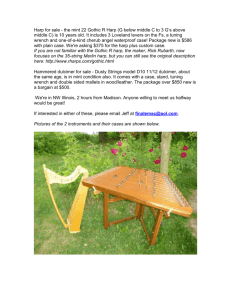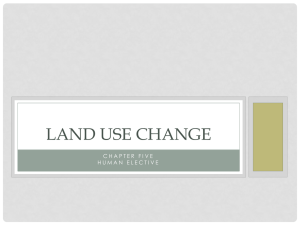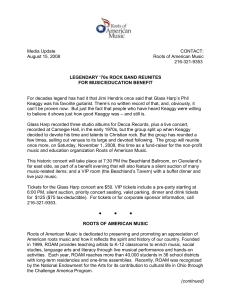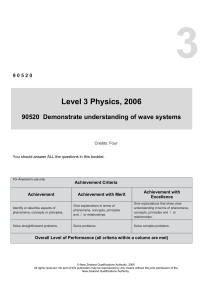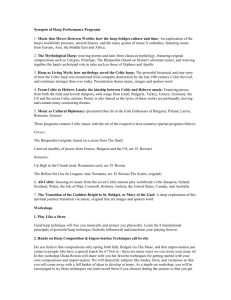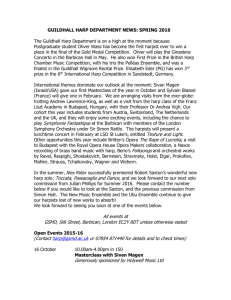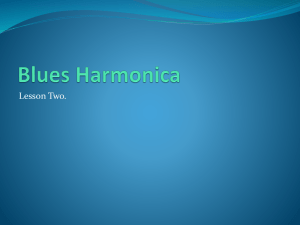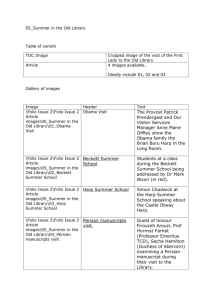Research paper - International Journal of Special Education
advertisement
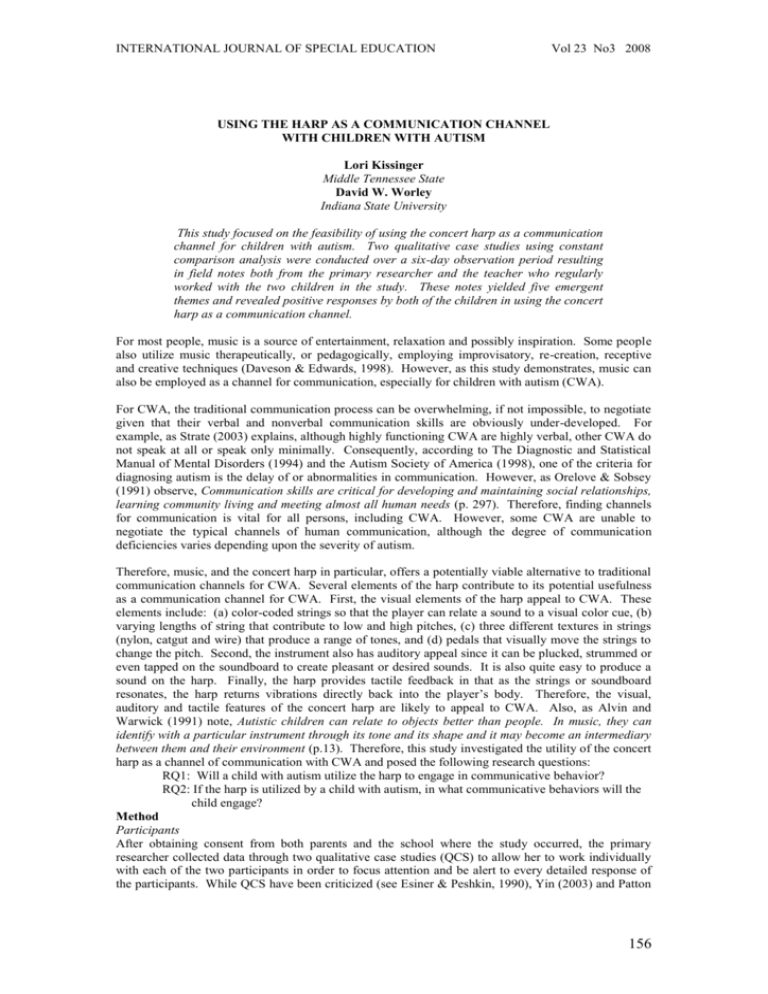
INTERNATIONAL JOURNAL OF SPECIAL EDUCATION Vol 23 No3 2008 USING THE HARP AS A COMMUNICATION CHANNEL WITH CHILDREN WITH AUTISM Lori Kissinger Middle Tennessee State David W. Worley Indiana State University This study focused on the feasibility of using the concert harp as a communication channel for children with autism. Two qualitative case studies using constant comparison analysis were conducted over a six-day observation period resulting in field notes both from the primary researcher and the teacher who regularly worked with the two children in the study. These notes yielded five emergent themes and revealed positive responses by both of the children in using the concert harp as a communication channel. For most people, music is a source of entertainment, relaxation and possibly inspiration. Some people also utilize music therapeutically, or pedagogically, employing improvisatory, re-creation, receptive and creative techniques (Daveson & Edwards, 1998). However, as this study demonstrates, music can also be employed as a channel for communication, especially for children with autism (CWA). For CWA, the traditional communication process can be overwhelming, if not impossible, to negotiate given that their verbal and nonverbal communication skills are obviously under-developed. For example, as Strate (2003) explains, although highly functioning CWA are highly verbal, other CWA do not speak at all or speak only minimally. Consequently, according to The Diagnostic and Statistical Manual of Mental Disorders (1994) and the Autism Society of America (1998), one of the criteria for diagnosing autism is the delay of or abnormalities in communication. However, as Orelove & Sobsey (1991) observe, Communication skills are critical for developing and maintaining social relationships, learning community living and meeting almost all human needs (p. 297). Therefore, finding channels for communication is vital for all persons, including CWA. However, some CWA are unable to negotiate the typical channels of human communication, although the degree of communication deficiencies varies depending upon the severity of autism. Therefore, music, and the concert harp in particular, offers a potentially viable alternative to traditional communication channels for CWA. Several elements of the harp contribute to its potential usefulness as a communication channel for CWA. First, the visual elements of the harp appeal to CWA. These elements include: (a) color-coded strings so that the player can relate a sound to a visual color cue, (b) varying lengths of string that contribute to low and high pitches, (c) three different textures in strings (nylon, catgut and wire) that produce a range of tones, and (d) pedals that visually move the strings to change the pitch. Second, the instrument also has auditory appeal since it can be plucked, strummed or even tapped on the soundboard to create pleasant or desired sounds. It is also quite easy to produce a sound on the harp. Finally, the harp provides tactile feedback in that as the strings or soundboard resonates, the harp returns vibrations directly back into the player’s body. Therefore, the visual, auditory and tactile features of the concert harp are likely to appeal to CWA. Also, as Alvin and Warwick (1991) note, Autistic children can relate to objects better than people. In music, they can identify with a particular instrument through its tone and its shape and it may become an intermediary between them and their environment (p.13). Therefore, this study investigated the utility of the concert harp as a channel of communication with CWA and posed the following research questions: RQ1: Will a child with autism utilize the harp to engage in communicative behavior? RQ2: If the harp is utilized by a child with autism, in what communicative behaviors will the child engage? Method Participants After obtaining consent from both parents and the school where the study occurred, the primary researcher collected data through two qualitative case studies (QCS) to allow her to work individually with each of the two participants in order to focus attention and be alert to every detailed response of the participants. While QCS have been criticized (see Esiner & Peshkin, 1990), Yin (2003) and Patton 156 INTERNATIONAL JOURNAL OF SPECIAL EDUCATION Vol 23 No3 2008 (2002) confirm the value and validity of QCS, especially in dealing with relatively unexplored areas of research (see Marshall & Rossmann, 1999). After obtaining consent, initial data collection involved a telephone interview as well as a personal interview with the special education teacher responsible for instructing the two participants for the study in order to gather background and to set guidelines for the study, in order to triangulate data (see Patton, 2002). In this conversation, the teacher and researcher agreed on times for six, forty-five minute observations of the CWA in their daily classroom setting in harmony with naturalistic, constructivist approaches to educational inquiry. Both children selected for the study were officially diagnosed with autism, male and 10-years old. Sam, as he will be named in this study, was mute, not particularly interested in music and had a high sensitivity to touch. In contrast, John, as he will be named in this study, had a high interest in music, tended to be social and could mutter a few words. Procedure Each day was marked by naturalistic observation, typical of QCS (see Denzin & Lincoln, 2003; Miles & Huberman, 1994; Punch 1998; Starke, 1998). After each day’s classroom observation, the primary researcher wrote field notes into a journal, which recorded the responses demonstrated by each child and interpretations of those responses. In the field notes, the primary researcher also earmarked responses that fell outside the initial expected responses for the child and/or that demonstrated an attempt to communicate. Each day, the special education teacher also wrote notes during the observation period regarding behavior that she felt demonstrated significant social and communication progress for each child, to offer multiple perspectives and enhance validity. She also verbally shared her observations with the primary researcher. Results Through constant comparison of the recorded observations, as well as ongoing conversations with the special education teacher, the primary researcher developed and integrated categories of behavior into emergent constructs (Lincoln & Guba, 1995). Five emergent themes were identified. First, both children left their routines and initiated participation with the unfamiliar instrument, the harp; they responded positively to the presence of the harp. The visual and auditory characteristics of the harp captured the boy’s attention. Second, both children bonded with the harp. John became possessive of the instrument, while Sam willingly gave up a cherished item to gain access to the harp, which is not surprising given CWA’s typical interest in objects. Third, both children became more socially engaged in that they acknowledged the primary researcher’s presence and participated in interactive activities with her through the harp, but not without the harp. For example, when the researcher played songs that Sam knew but left off the end of the song, such as Old Mac Donald, Sam reached up to the harp and strummed in the appropriate rhythmic pattern to provide the missing part of the song. Additionally, each day, John repeated a knocking pattern that the researcher initiated on the soundboard of the harp. He also reached through the strings of the instrument with his fingers and took the researcher’s fingers in his own. However, neither boy acknowledged that the primary researcher was even in the classroom at any other time except when the researcher was sitting at the harp, which resonates with prior research that identifies impairments with social interaction as one of the characteristic traits of CWA (see Strate, 2003). Two especially significant events transpired while the primary researcher interacted with Sam using the harp, especially given Sam’s lack of communication responses. First, although eye contact is often difficult for CWA, one day, Sam made direct eye contact as he played the harp; he would not make direct eye contact with either the researcher or his teacher at any other time. Second, early on, Sam’s teacher expressed that he was not teachable since he provided no feedback through verbal or nonverbal cues to indicate that he understood any information that was communicated to him; therefore his teacher believed that his intelligence level was quite low. However, on the last day of observations, the primary researcher placed a picture of a yellow duck on a music stand. The researcher said, Sam, Sam is the duck blue (and strummed high notes), yellow (and strummed middle notes) or green (and strummed low notes)? The researcher repeated the same prompt about three times. Sam then circled the music stand and the harp and eventually strummed the middle notes and walked away. The primary researcher tried additional prompts. For example, she put a picture of a circle on the music stand and said Sam, Sam is this a picture of a circle (and strummed high notes), or a square (and strummed middle notes), or a triangle (and strummed low notes)? Once again Sam circled the harp and played the correct corresponding section. To test the validity of this approach, the primary research used 157 INTERNATIONAL JOURNAL OF SPECIAL EDUCATION Vol 23 No3 2008 additional prompts including letters and numbers and changed sections of the harp that related to the correct answer so that Sam could not continue to strum the same place and get the question correct; he always responded correctly. Fourth, both boys demonstrated enhanced nonverbal behavior through smiles, eye contact and reaching for the primary researcher through the strings. While this behavior was not as dramatic for John, as it was for Sam, both boys were stimulated and engaged in interactive behavior. Fifth, both Sam and John were more vocal. While they did not necessarily speak words per se, the boys vocalized a variety of oral sounds. This was especially significant, according to the classroom teacher, given that Sam rarely ever vocalized and was labeled mute. While these vocalizations should not be considered symbolic communication per se, once again both boys’ attention was aroused and they engaged in interactive behavior through the harp. The children’s initial reaction to the harp was surprising considering that CWA have a desire for sameness (Olney, 2000) and given that the special education teacher noted that both children operated on a strict routine, as is common for CWA (see Strate, 2003). However, if the children’s initial interest in the harp had been merely a fleeting curiosity, using the harp to initiate communicative behavior would not have been possible. Once it was evident that the children had an attachment for the instrument, the possibility existed for them to use the harp as a communication channel, which they appeared to do. Specifically, the nonverbal responses and the vocalizations connected to playing the harp demonstrated an interest in using the harp as a communication channel. While one must guard against the assumption that the boys engaged in true symbolic communication given the nature of symbolic communication (see Langer, 1969) and the difficulty CWA’s encounter with social interaction and meaning making (see Strate, 2003), the harp obviously stimulated them to engage in communicative behavior. Discussion Socialization, nonverbal response and vocalization are all elements of the communication process (Scott, Clark & Brady, 2000). Moreover, since communication is a social process involving verbal and/or nonverbal elements (Sands & Jeffers, 1999), in this study the CWA demonstrated both verbal and nonverbal communication behavior and engaged in basic social interaction using the harp as a channel for communication. As Hanneman & McEwen (1975) stated, objects do have the potential to be used as a communication channel and this study demonstrated that the potential exists for the harp to become a communication channel for CWA. Moreover, this study suggests that the harp may serve as another tool for enhancing the discrete trial technique that appears to be one of the most promising therapies for CWA (see Smith, Goren & Wynn, 2000). Although this study has provided interesting and initial observations, it included only two cases, one primary researcher, and a limited amount of time for the observations. Therefore, this study lacks generalizability, although, as is often the case in qualitative research, it demonstrates verifiability (see Patton, 2002). Therefore, one must exercise caution in drawing any conclusions. At the same time, this study prompts intriguing questions for future study. Future research should, therefore, explore additional ways to open the door of communication for CWA, including further study of the harp since it possesses many of the visual elements that appeal to children with autism and allows for social interaction. Additional studies using the harp with CWA seem particularly warranted. In particular, we suggest that a variety of individuals should seek to interact with CWA in order to test whether the harp appears to be a critical factor. The observations made in this study provide a beginning for further research and demonstrate that the harp has the potential to be used as a communication channel for CWA. If the harp can open the door for just a few children, then further study into this issue is worthwhile. References Alvin, J. & Warwick, A. (1991). Music therapy for the autistic child (2nd ed.). New York: Oxford University Press. American Psychiatric Association (1994). Diagnostic and statistical manual of mental disorders (4th ed.). Washington, DC: Author. Autism Society of America. (1998). The advocate: The newsletter of the Autism Society of America, 30. Bethesda, MD: Author. Daveson, B. & Edwards, J. (1998). A role for music therapy in special education. International Journal of Disability, Development, and Education, 45, 449-457. 158 INTERNATIONAL JOURNAL OF SPECIAL EDUCATION Vol 23 No3 2008 Denzin, N. K. & Lincoln Y. S. (Eds) (2003). Strategies of qualitative inquiry (2nd ed.). Thousand Oaks, CA: Sage. Eisner, E. W. & Peshkin, A. (1990). Qualitative inquiry in education: The continuing debate.New York: Teachers College Press. Hanneman, G. J. & McEwen, W. J. (1975). Communication and behavior. London: Addison-Wesley. Langer, S. K. (1969). Philosophy in a new key: A study in the symbolism of reason, rite, and art(3rd ed.). Cambridge, MA: Harvard University Press. Lincoln, Y. S. & Guba, E. G. (1985). Naturalistic inquiry. Newbury Park, CA: Sage. Marshall, C. & Rossmann, G. B. (1991). Designing qualitative research (3rd ed.). London: Sage. Miles, M. B. & Huberman, A. M. (1994). Qualitative data analysis: A sourcebook of new methods (2nd ed.). Thousand Oaks, CA: Sage. Olney, M. F. (2000). Working with autism and other social-communication disorders. Journal of Rehabilitation, 66, 51-57. Patton, M. Q. (2002). Qualitative research and evaluation methods (3rd ed.). Thousand Oaks, CA: Sage. Orelove, F. P. & Sobsey, D. (1991). Educating children with multiple disabilities (2nd ed.). Baltimore: Paul H. Brooks. Punch, K. F. (1998). Introduction to social research: Quantitative and qualitative approaches. London: Sage. Sanders, S. & Jeffers, R. (1999). Public conversations: Building skills and confidence (4th ed.). New York: McGraw-Hill. Scott, J., Clark, C. & Brady, M. P. (2000). Students with autism. San Diego, CA: Singular. Smith, T., Goren, A. D., Wynn. J. W. (2000). Randomized trial of intensive early intervention for children with pervasive developmental disorder. American Journal on Mental Retardation, 105, 269285. Starke, R. E. (1998). Case studies. In N. K. Denzin & Y. S. Lincoln (Eds.), Strategies of qualitative inquiry, ( pp. 86-109). Thousand Oaks, CA: Sage. Strate, L. (2003). Something from nothing: Seeking a sense of self. ETC.: A Review of General Semantics, 60, 4-21 Yin, R. K. (2003). Case study research: Design and methods (3rd ed.). Thousand Oaks, CA:Sage. 159
